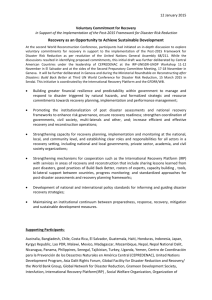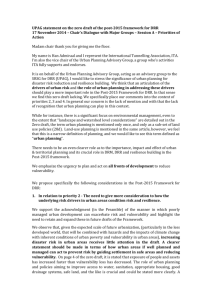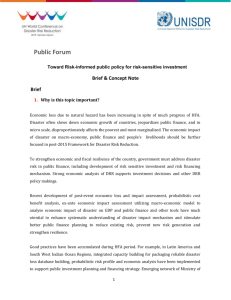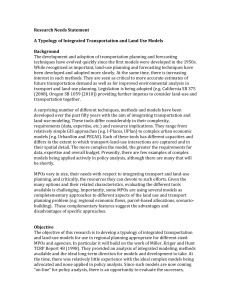Land Use Planning for Disaster Risk Reduction
advertisement
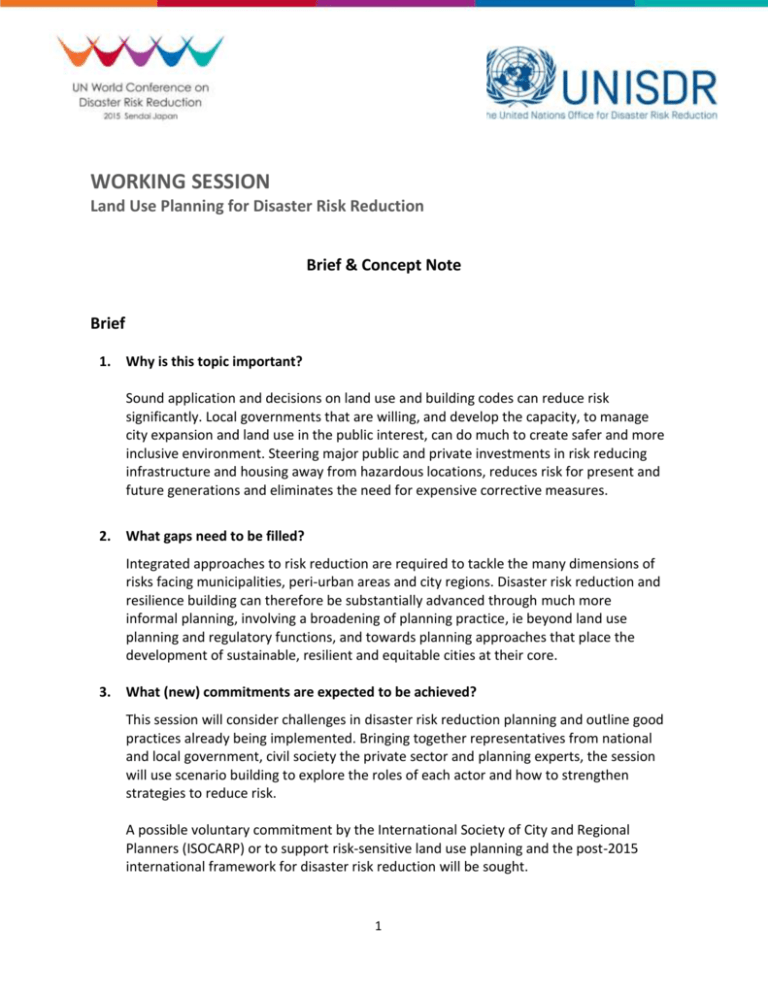
WORKING SESSION Land Use Planning for Disaster Risk Reduction Brief & Concept Note Brief 1. Why is this topic important? Sound application and decisions on land use and building codes can reduce risk significantly. Local governments that are willing, and develop the capacity, to manage city expansion and land use in the public interest, can do much to create safer and more inclusive environment. Steering major public and private investments in risk reducing infrastructure and housing away from hazardous locations, reduces risk for present and future generations and eliminates the need for expensive corrective measures. 2. What gaps need to be filled? Integrated approaches to risk reduction are required to tackle the many dimensions of risks facing municipalities, peri-urban areas and city regions. Disaster risk reduction and resilience building can therefore be substantially advanced through much more informal planning, involving a broadening of planning practice, ie beyond land use planning and regulatory functions, and towards planning approaches that place the development of sustainable, resilient and equitable cities at their core. 3. What (new) commitments are expected to be achieved? This session will consider challenges in disaster risk reduction planning and outline good practices already being implemented. Bringing together representatives from national and local government, civil society the private sector and planning experts, the session will use scenario building to explore the roles of each actor and how to strengthen strategies to reduce risk. A possible voluntary commitment by the International Society of City and Regional Planners (ISOCARP) or to support risk-sensitive land use planning and the post-2015 international framework for disaster risk reduction will be sought. 1 Concept Note Schedule Monday 16 March 2015, 16:00-17:30 Room and Venue Hagi Hall, Sendai International Conference Centre Organizing Team Member States Government of Colombia, National Unit of Disaster Risk Management Representative of an African State (tbc) Members of the SRSG’s Urban Planning Advisory Group: - Barbara Lipietz, University College London, UK - Richard Sliuzas, University of Twente, Netherlands - Jorgelina Hardoy, Instituto Internacional de Medio Ambiente y Desarrollo de América Latina, Argentina UNISDR Focal Points Ricardo Mena (rmena@eird.org) Background and Rationale See box above Session Objectives 1. Present good practices and challenges surrounding the incorporation of risk reduction in existing land-use planning and management practices at the local level. 2. Make practical recommendations on how to ensure that local governments have access to the information, tools and capacities necessary to develop and implement risk-sensitive land-use planning. 3. Reframe land-use planning towards a more transformative notion of planning that puts the development of risk-sensitive, resilient and sustainable cities and communities at its core. Discussion agenda and structure The session will evolve around a multi-hazard scenario. Panelists will be asked to reflect on their approach and tools at hand to manage the hypothetical situation. The session will address how to progress from the state of managing contradictory interests, money versus safety and growth versus better overall planning and the following interrelated issues: - What are the main constraints of DRR-informed planning (in terms of resources, institutional capacities, etc.)? - In what ways must land-use planning be supplemented to make for more risk-sensitive and resilient-building planning (stakeholders, scale, etc.)? 2 - How best to move from DRR planning to DRR implementation, reconciling conflicting priorities between access to land, natural hazards, climate change and rapid urbanization? Proposed scenario: 1. Introduction and welcoming remarks by Explanation of the session’s dynamic (5 mns). Moderator. 1a. Setting the stage: A city of approximately 1 million inhabitants with flood risk affecting an area of mixed uses that includes an industrial site and an informal settlement lacking most basic services. The flood risk in this case is associated with rains in the upper basin (outside the city´s administrative area) and incomplete or not adequately maintained risk reduction infrastructure work along the river basin. 1b. Presentation of panelists: a. Government representative b. Mayor participating in the MCR campaign c. International expert in land use planning d. Civil society organization e. Private sector - Representing developers or infrastructure building companies Panelists will discuss their approach to address the flood risk situation presented, given the role they have and existing strengths and constraints within their own working structures (5x7 mns). 2. Moderated discussion (30 mns): This will trigger a discussion on institutional frameworks (ideal vs possible), priority actions, appropriate plans and tools, and long term approach for transformative planning. The conversation will be opened to the floor after comments by 3 specialized commentators. 3. Wrap up by panelists (5x3 mns) 4. Wrap and conclusion by the moderator (5 mns) Expected outcomes The session will make practical recommendations on how to ensure that local governments have access to the information, tools and capacities necessary to develop and implement risksensitive land-use planning ready for implementing a post2015 framework for disaster risk reduction. 3 Commitment / special announcement in support of a post-2015 framework for DRR To be confirmed Expected number of participants 500 Background documents C Suggested: GAR 2011 contributing paper: Creating an enabling environment for reducing disaster risk: Recent experience of regulatory frameworks for land, planning and building in low and middle-income countries (Cassidy Johnson) 4





